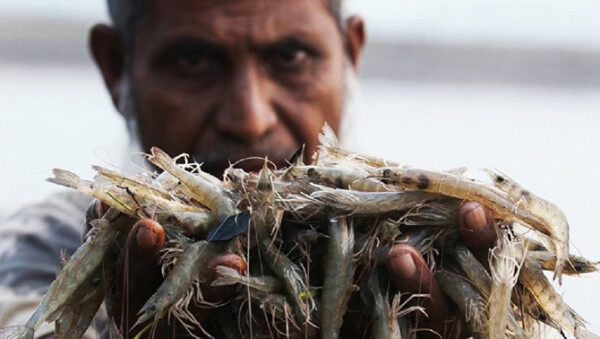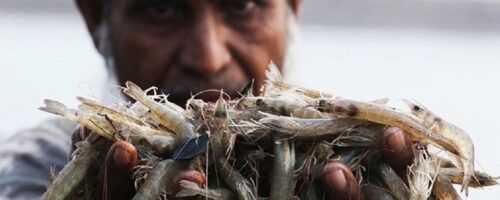
Mongla Upazila, Bangladesh
How is it produced?
Farmed shrimp are produced in man-made brackish ponds that are created by clearing mangrove forests and farmland in the coastal areas of Southeast Asia, South America, and Africa. The fry are often wild-caught and then raised in the ponds, supported by antibiotics and numerous chemicals to reduce disease, of which farmed shrimp are highly susceptible.
Farming practices have been found to be detrimental to the socioeconomic well being of these nations, as well as to the environment. Human rights abuses are well documented in the shrimp farm industry, including human trafficking, torture, and sexual harassment (Bhattacharya, et al., 1999; Held, 2019; SSNC, 2011). Environmental destruction, such as significant biodiversity and habitat loss, has also been extensively recorded. In addition to the chemical pollution (some of which are banned), over 38% of the world’s mangrove forests have been cleared for intensive shrimp farming (Held, 2019; SSNC, 2011).
Describe the supply chain to the store shelf in Canada:
Shrimps are harvested from the ponds and then processed and shipped to largely Northern countries for consumption. The supply chains are often long and complex in the shrimp industry, making transparency of labor practices and farming methods difficult to track (Held, 2019). As described by Lisa Held (2019), “A bag of wild-caught Argentine red shrimp for sale at Giant in Maryland was labeled as a product of Argentina and processed in Thailand — meaning it had traveled, at a minimum, from South America to Asia to North America” (para. 6).
What is the power balance between the producer and seller?
The producers of farmed shrimp are often not from the local communities where the farms operate, but rather foreigners and imported workers (SOS-arsenic, 2014; SSNC, 2011). The locals affected by shrimp farming – either by pollution, loss of the common land, or human rights abuses – have attempted numerous uprisings, however, the protestors are often met with extreme violence (Bhattacharya, et al., 1999; Reeves, et al., 2014; SOS-arsenic, 2014; SSNC, 2011).
Can you recommend changes to the system to improve the balance?
There are many suggestions on how to improve the shrimp industry. Certification by third-party companies that the product has been farmed to higher standards is one method, however, there is no government oversight in the certification process, and in many cases, the boards of these organizations are loaded with corporate players, effectively creating a system of ‘industry labeling industry’ (Held, 2019). Without development of globally-mandated and enforced policies meant to improve worker conditions and environmental practices in this industry, it is highly unlikely that the multinational corporations that operate these farms will voluntarily invest in any improvement schemes, as they would raise production costs, and therefore, reduce revenue.
References/Resources:
References
Bhattacharya, D., Mustafizur R., & Khatun, F.A. (November, 1999). Environmental Consequences of Structural Adjustment: Towards Sustainable Shrimp Culture in Bangladesh. Centre for Policy Dialogue. http://www.cpd.org.bd/pub_attach/op2.pdf
Held, L. (2019, November 11). What You Need to Know About Wild and Farmed Shrimp. Foodprint. https://foodprint.org/blog/wild-and-farmed-shrimp/
Reeves, P., Pokrant, B., McGuire, J. (2014). Changing Practice in the Madras Marine Fisheries: Legacies of the Fish Curing Yards. In: Christensen, J., Tull, M. (eds) Historical Perspectives of Fisheries Exploitation in the Indo-Pacific (pp. 41-61). MARE Publication Series, vol 12. https://doi.org/10.1007/978-94-017-8727-7_3
SOS-arsenic.net (2014, August 8). Third World communities fight the “Blue Revolution”. http://www.sos-arsenic.net/english/environment/shrimp.html
Swedish Society for Nature Conservation (SSNC). (2011, September 29). The devastating truth behind shrimp farming [Video]. Youtube. https://youtu.be/hPJpPEH3l7o

